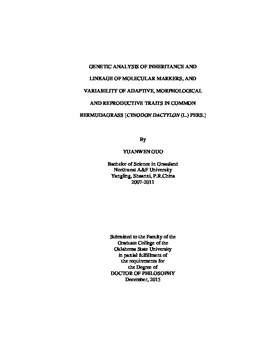| dc.contributor.advisor | Wu, Yanqi | |
| dc.contributor.author | Guo, Yuanwen | |
| dc.date.accessioned | 2016-09-29T18:45:29Z | |
| dc.date.available | 2016-09-29T18:45:29Z | |
| dc.date.issued | 2015-12 | |
| dc.identifier.uri | https://hdl.handle.net/11244/45358 | |
| dc.description.abstract | Common bermudagrass [Cynodon dactylon (L.) Pers.] is economically and environmentally the most important member among Cynodon species because of its extensive use for turf, forage and soil erosion control in the world. However, information regarding the inheritance, genetic linkage and cold germplasm variability analysis within this taxon is limited. Therefore, the objectives of this study were 1) to determine qualitative inheritance mode in common bermudagrass; 2) to construct a genetic map based on simple sequence repeats markers for common bermudagrass; and 3) to quantify genetic variability and determine relationships among turf performance and reproductive traits. Two tetraploid (2n=4x=36), first-generation selfed populations, 228 progenies of 'Zebra' and 273 from A12359, were analyzed for segregation with simple sequence repeat markers in the first project. It was concluded that the inheritance mode of tetraploid bermudagrass was complete or near complete disomic, and the two bermudagrass parents had an allotetraploid genome with two distinct subgenomes. Severe transmission ratio distortions occurred in the Zebra population while less so in the A12359 population, so A12359 population was used for linkage analysis and bermudagrass map construction in the second project. A total of 249 simple sequence repeat primer pairs were mapped to 18 linkage groups. The total length for the map was 1094.7 cM with an average marker interval of 4.3 cM, and length for individual linkage groups ranged from 122.3 cM for LG 18 to 12.7 cM for LG 6. Comparative mapping was conducted to compare genomes of common bermudagrass, sorghum (Sorghum bicolor L.) and foxtail millet (Setaria italica L.), and three conservative regions among these three species were discovered in the study. The findings of disomic inheritance and construction of linkage map could be beneficial for quantitative trait loci mapping, marker assisted selection and other genome study in common bermudagrass. The third project focused on quantifying the genetic variability of important adaptive, morphological and reproductive traits in cold hardy common bermudagrass populations and testing possible correlations among these traits. Substantial and significant genetic variances were observed in our germplasm, which could be utilized in bermudagrass breeding programs such as producing interspecific hybrids and synthetic cultivars. | |
| dc.format | application/pdf | |
| dc.language | en_US | |
| dc.rights | Copyright is held by the author who has granted the Oklahoma State University Library the non-exclusive right to share this material in its institutional repository. Contact Digital Library Services at lib-dls@okstate.edu or 405-744-9161 for the permission policy on the use, reproduction or distribution of this material. | |
| dc.title | Genetic analysis of inheritance and linkage of molecular markers, and variability of adaptive, morphological and reproductive traits in common bermudagrass [Cynodon dactylon (L.) Pers.] | |
| dc.contributor.committeeMember | Anderson, Jeff A. | |
| dc.contributor.committeeMember | Moss, Justin Q. | |
| dc.contributor.committeeMember | Zhu, Lan | |
| osu.filename | Guo_okstate_0664D_14324.pdf | |
| osu.accesstype | Open Access | |
| dc.type.genre | Dissertation | |
| dc.type.material | Text | |
| thesis.degree.discipline | Crop Science | |
| thesis.degree.grantor | Oklahoma State University | |
